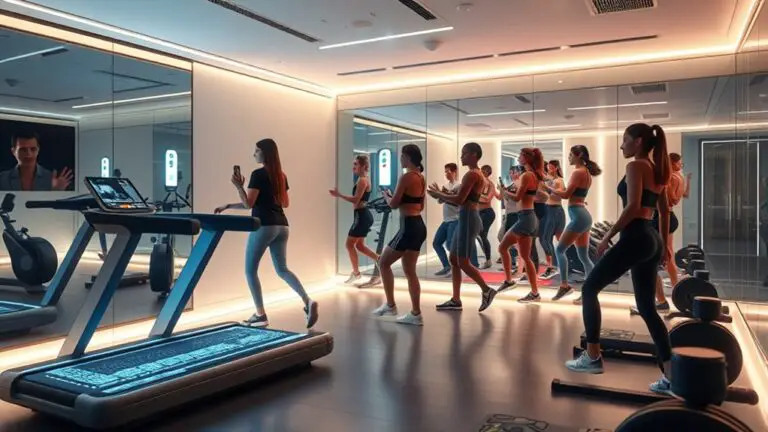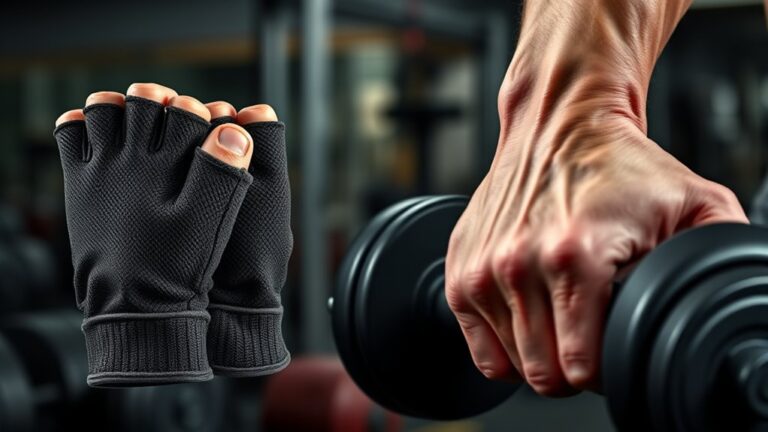How to Pick the Best Lifting Belt for Your Training Style
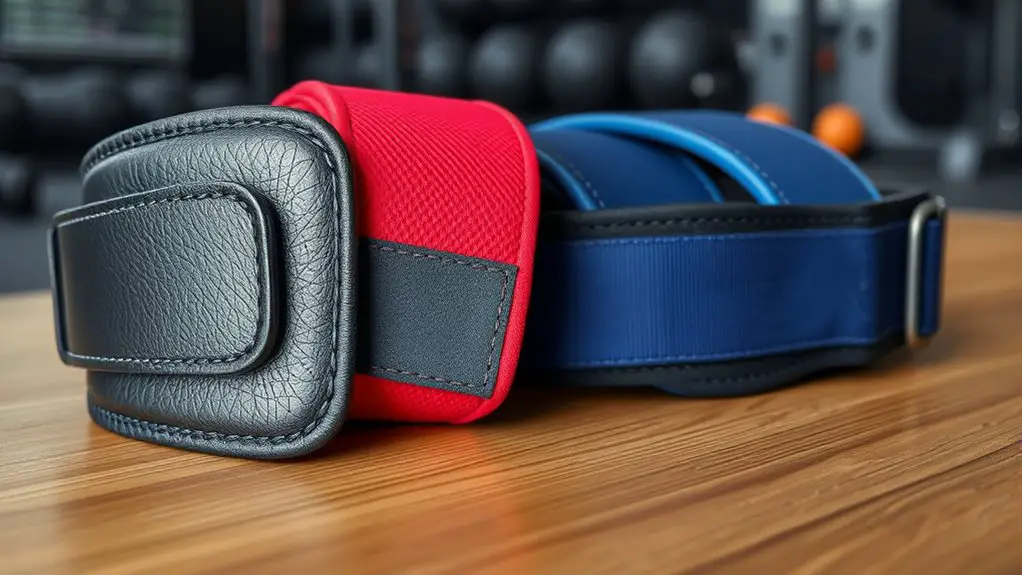
To pick the best lifting belt for your training style, consider its purpose, material, width, and thickness. For heavy lifts, a powerlifting belt offers stability, while Olympic belts suit dynamic movements. Materials like leather provide durability, while nylon is lighter but less long-lasting. Make certain the belt fits snugly without being too tight, and remember that comfort and flexibility are essential for performance. Exploring more can help you understand the nuances that enhance your lifting experience.
Understanding the Purpose of a Lifting Belt
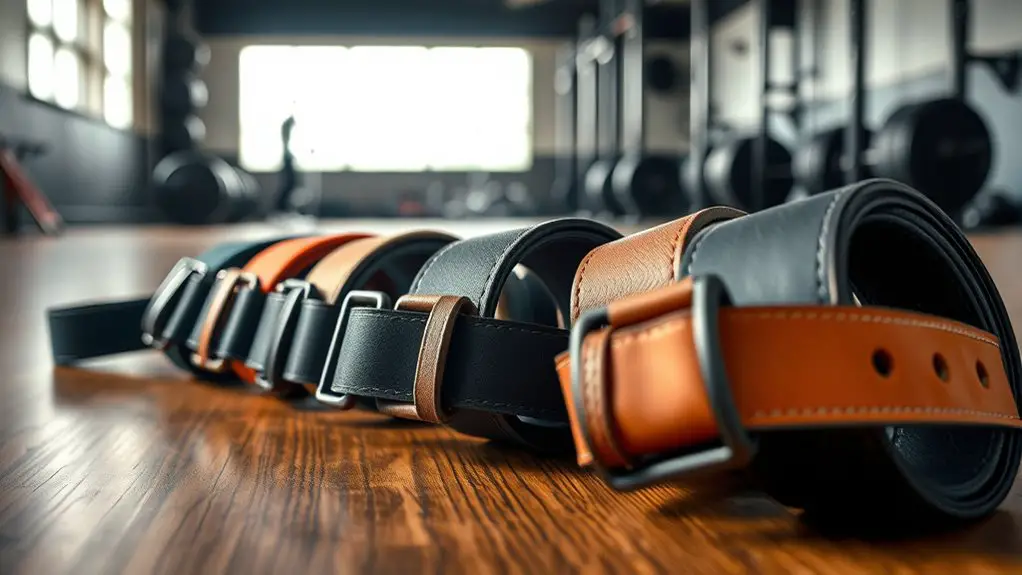
A lifting belt serves an essential role in weightlifting by providing support to your lower back and core during heavy lifts. This support enhances intra-abdominal pressure, stabilizing your spine and reducing the risk of injury. When you engage in maximal or near-maximal efforts, the benefits of support become even more pronounced. The belt helps maintain proper form, ensuring that your back remains aligned and reducing the likelihood of unnecessary strain.
In addition to enhancing performance, wearing a lifting belt is a proactive approach to injury prevention. By acting as a brace, it can help mitigate the forces exerted on your lumbar region, particularly during compound movements like squats and deadlifts. This protective mechanism is especially important for athletes who frequently lift heavy loads. Ultimately, understanding the purpose of a lifting belt is essential for optimizing your training and safeguarding your body against potential injuries.
Types of Lifting Belts: Which One Is Right for You?
When it comes to lifting belts, choosing the right type can greatly impact your performance and safety. You’ll find various options tailored for specific lifting styles, each with unique benefits. Here’s a quick overview:
- Powerlifting Belts: Designed for maximum support during heavy lifts like squats and deadlifts, they typically feature a wider back for stability.
- Olympic Lifting Belts: These are often thinner and more flexible, allowing for greater mobility when performing dynamic movements like cleans and snatches.
- Velcro Belts: Ideal for those who prefer quick adjustments, these belts are lightweight and often used in functional training.
- Lever Belts: Featuring a secure lever mechanism, these belts provide a snug fit and are commonly used in powerlifting.
- Traditional Buckle Belts: Known for their durability, these belts offer a classic design and reliable support for various lifts.
Selecting the right belt can enhance your lifting experience and help prevent injury.
Material Matters: Leather vs. Nylon vs. Suede
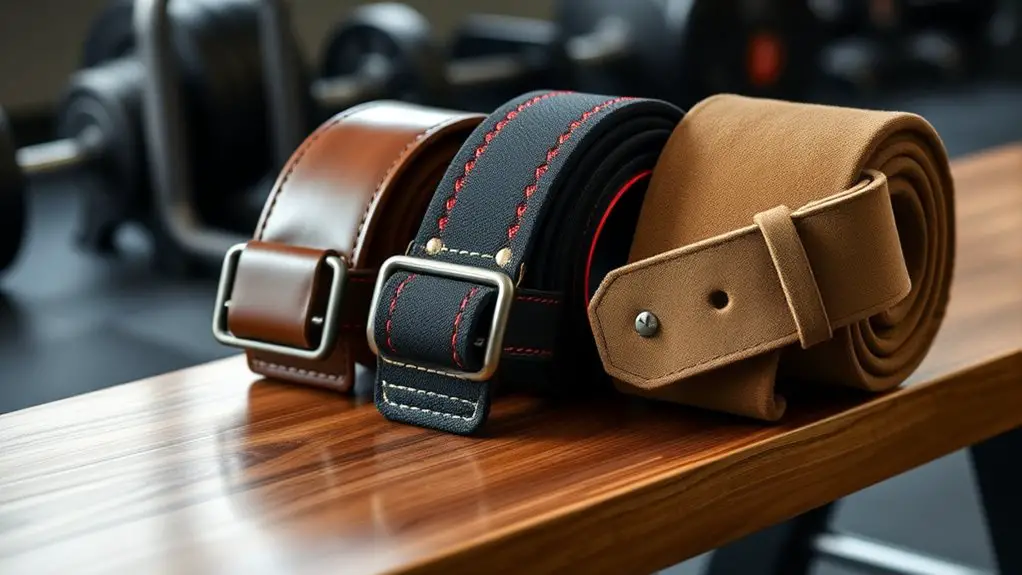
When selecting a lifting belt, the choice of material greatly influences both durability and comfort. Leather offers superior longevity but may lack the flexibility found in nylon or suede options. Understanding these differences can help you make an informed decision that balances support with ease of movement.
Durability and Longevity
Choosing the right material for a lifting belt is essential, as it directly impacts durability and longevity. Each material has its own strengths and weaknesses that affect how well it withstands wear and tear. Here are some factors to take into account:
- Leather: Highly durable, but requires proper maintenance.
- Nylon: Resistant to moisture and lightweight, but may wear out faster.
- Suede: Offers a good grip, though it can be prone to scuffs.
- Stitching quality: Confirm strong seams to prevent early breakdown.
- Thickness: Thicker belts generally last longer, but weigh more.
Comfort and Flexibility
While durability is essential, comfort and flexibility also play a significant role in selecting a lifting belt that suits your needs. The material you choose directly impacts how well the belt adapts to your body during lifts. Leather belts offer excellent support but may lack breathability, potentially causing discomfort. Nylon belts, known for their flexibility and lightweight nature, often incorporate breathable materials, enhancing airflow and moisture management. Suede provides a middle ground, offering some breathability while maintaining structural integrity. Additionally, consider adjustable features in your belt. A well-designed lifting belt should allow for a customized fit, accommodating changes in your body or workout intensity, ensuring you maintain comfort throughout your training sessions.
Belt Width and Thickness: Finding the Right Fit
To guarantee ideal support during heavy lifts, understanding the appropriate belt width and thickness is essential. The right combination can enhance your performance based on your lifting style and body mechanics. Here are key considerations when selecting your lifting belt:
- Belt Width: Generally, a width of 4 inches is standard for powerlifting, providing maximum support.
- Thickness: A thickness of 10mm to 13mm offers robust support for heavy lifts, while thinner belts may be better for dynamic movements.
- Belt Size: Confirm it fits snugly without being overly tight to allow for best compression.
- Lifting Style: Consider whether you’re focused on Olympic lifting, powerlifting, or bodybuilding, as this influences your belt choice.
- Personal Comfort: Test various widths and thicknesses to find what feels best for your body type and lifting technique.
Choosing the right belt size, width, and thickness can greatly impact your lifting performance.
Sizing Your Lifting Belt Correctly
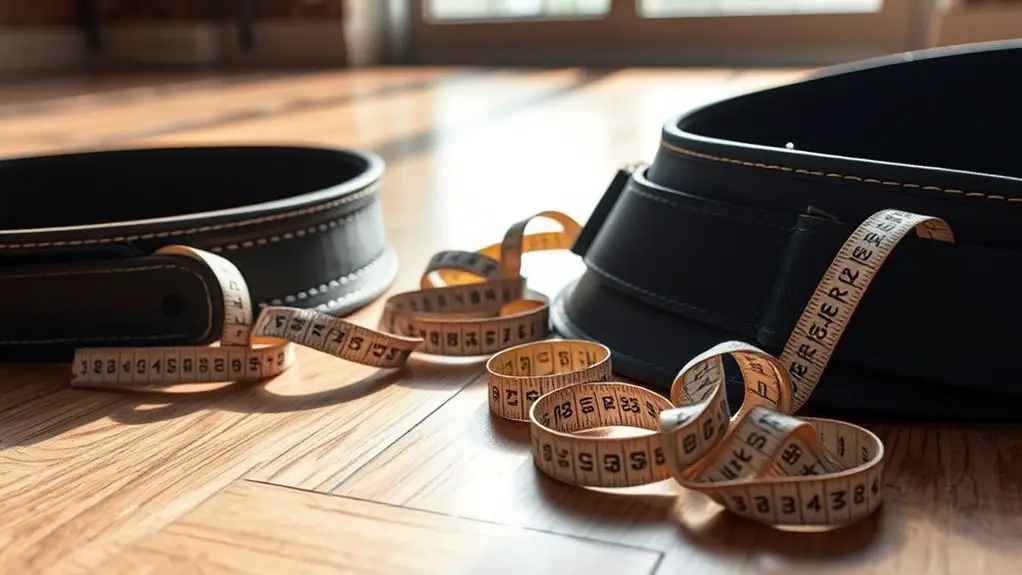
Getting the right fit for your lifting belt is vital for maximizing support and performance. To guarantee you select the correct size, it’s important to utilize effective belt measurement techniques. Start by measuring your waist at the level where the belt will sit, typically around the navel.
Here’s a handy sizing chart reference to assist you:
| Waist Measurement (inches) | Belt Size (inches) |
|---|---|
| 26 – 30 | Small |
| 30 – 34 | Medium |
| 34 – 38 | Large |
| 38 – 42 | X-Large |
| 42 – 46 | XX-Large |
Once you’ve determined your size, double-check your measurements to confirm accuracy. Remember, a well-fitted belt won’t be too tight or loose, allowing for ideal support while lifting.
Buckle Types: Lever vs. Prong vs. Velcro
When selecting a lifting belt, the buckle type plays an essential role in performance and convenience. Understanding the differences can help you make a more informed choice.
Selecting the right lifting belt buckle is crucial for enhancing performance and ensuring convenience during workouts.
- Lever Advantages: Quick adjustments and a secure fit, ideal for heavy lifting.
- Prong Disadvantages: Takes longer to adjust and may not provide the same level of security as lever belts.
- Velcro Convenience: Easiest to put on and take off, offering flexibility during workouts.
- Durability: Lever belts often last longer, while Velcro can wear out faster.
- Weight: Prong belts are typically lighter, which may be a consideration for some lifters.
In this buckle comparison, consider your training style and comfort. If you prioritize speed and security, a lever belt may be best, while a Velcro belt could work well for those who value convenience.
The Importance of Comfort and Flexibility
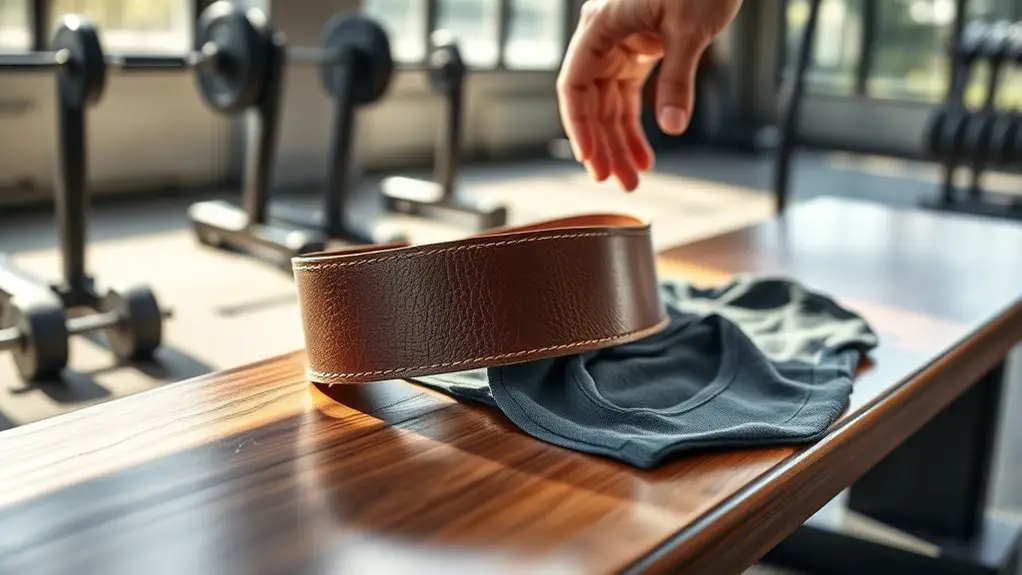
While many lifters focus on the sturdiness of lifting belts, comfort and flexibility are equally vital for peak performance. An adjustable design allows you to customize the fit, ensuring the belt hugs your body without restricting movement. This is essential, as a belt that’s too tight can hinder your lifting mechanics, while one that’s too loose may not provide adequate support.
Look for belts with ergonomic features, which conform to your body’s natural shape and allow for a full range of motion. The right combination of comfort and flexibility can greatly enhance your training experience, enabling you to focus on your lifts rather than adjusting your gear. Remember, a belt that feels good encourages proper technique and reduces the risk of injury. Prioritizing these aspects will ultimately lead to better performance in the long run, making your investment in a lifting belt worthwhile.
Budget Considerations: Investing in Quality
Although budget constraints are a common concern, investing in a high-quality lifting belt can markedly enhance your performance and safety. When evaluating your options, consider how the initial cost can translate into long-term benefits. Here are key factors to keep in mind:
- Material Quality: Look for durable materials that withstand wear and tear.
- Design and Support: A well-designed belt provides ideal support, reducing injury risks.
- Fit and Comfort: A comfortable fit encourages proper lifting techniques.
- Adjustment Mechanism: Quality belts offer reliable adjustability for personalized support.
- Longevity of Investment: Higher-quality belts tend to last longer, saving you money in the long run.
Choosing a lifting belt isn’t just about staying within a budget; it’s about prioritizing quality to guarantee a safe and effective training experience. Investing in a good belt pays off through improved performance and durability.
Brand Reputation and Reviews
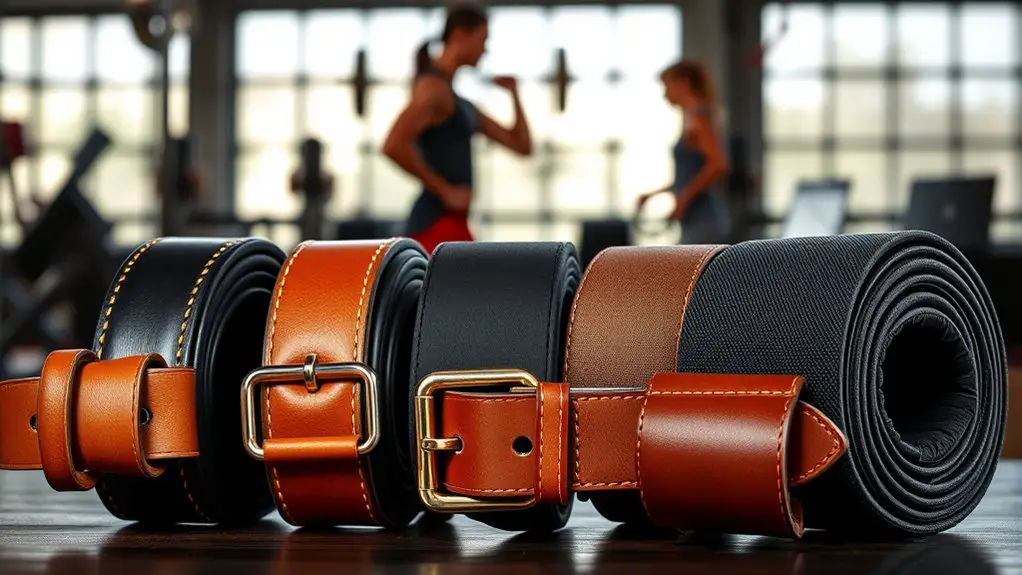
Brand reputation greatly influences your choice of a lifting belt, as it reflects the experiences of other users and the manufacturer’s commitment to quality. When analyzing brands, consider their history in the industry. Established brands often have a track record of producing reliable and durable products, which can be a significant indicator of performance.
Customer testimonials play an essential role in evaluating brand reputation, as they provide firsthand accounts of user satisfaction and belt efficacy. Look for patterns in reviews—consistent praise or complaints can highlight specific strengths or weaknesses in a brand’s offerings.
Additionally, be wary of brands with numerous negative reviews or unresolved customer issues, as these can signal potential problems with quality or customer service. Balancing brand history and customer feedback will help you make an informed decision and ultimately select a lifting belt that meets your training needs effectively.
Testing Your Belt: Ensuring Proper Functionality
To make certain your lifting belt functions properly, start by checking its fit and comfort during movement. A well-fitted belt should provide adequate support without restricting your range of motion. Additionally, assess the durability of the materials used to verify that it maintains structural integrity under heavy loads.
Check Fit and Comfort
Finding the right fit and comfort for your lifting belt is essential for maximizing performance and preventing injury. You should consider various belt adjustment techniques and personal preference factors to guarantee a superior fit. Here are key aspects to evaluate:
- Belt Width: Choose a width that suits your body type and leverages support.
- Material Flexibility: Assess how the material molds to your body during lifts.
- Adjustment System: Test different closures (e.g., prong, lever) for ease of use.
- Positioning: Verify the belt sits comfortably on your waist without restricting movement.
- Breathability: Check if the belt allows airflow, especially during intense workouts.
Prioritize comfort to enhance your lifting experience and achieve your training goals.
Assess Durability and Support
While comfort is essential, evaluating the durability and support of your lifting belt is equally important for best performance. Start by examining the material strength; high-quality leather or reinforced nylon typically offers superior longevity and resistance to wear. Check for any signs of fraying or deterioration, as these can compromise the belt’s effectiveness during heavy lifts. Next, focus on stitching quality. A well-stitched belt should have tight, even seams, which enhance both durability and support. Loose or uneven stitching can lead to premature failure, especially under heavy loads. By thoroughly reviewing these aspects, you guarantee your lifting belt will withstand rigorous training sessions, providing the necessary support to maximize your performance safely.
Frequently Asked Questions
Can I Use a Lifting Belt for All Types of Workouts?
Yes, you can use a lifting belt for various workouts, but it’s essential to understand its benefits and limitations. While a lifting belt provides support during heavy lifts, it’s not always necessary for lighter workouts or cardio. For strength training, it enhances core stability, especially during compound movements. However, for workout variations like agility drills or bodyweight exercises, relying solely on a belt might hinder your natural movement patterns. Use it wisely, based on your training focus.
How Often Should I Replace My Lifting Belt?
You should replace your lifting belt when you notice certain signs indicating it’s worn out. Look for fraying edges, cracks in the material, or a loss of stiffness; these are clear signs replacement’s needed. To prolong your belt’s life, follow belt maintenance tips like cleaning it regularly and storing it properly. Generally, if you use your belt frequently, consider replacing it every 1-3 years, depending on wear and tear.
Do Lifting Belts Prevent Injuries?
Lifting belts can aid in injury prevention by providing support to your lower back and core during heavy lifts. When you use proper lifting techniques, a belt helps stabilize your spine, reducing the risk of strain. However, it’s essential to remember that a belt isn’t a substitute for good form or strength training. Incorporating it wisely into your routine can enhance safety, but relying solely on it might lead to overconfidence and potential injury.
Can I Wear a Lifting Belt During Cardio?
Wearing a lifting belt during cardio might seem counterintuitive, as belts are typically associated with heavy lifting. However, if you’re focusing on high-intensity cardio, a lifting belt can enhance core stability, potentially improving your cardio effectiveness. It can help maintain proper posture, reducing injury risks. Just keep in mind that for low-intensity cardio, a belt may be unnecessary and could limit your movement. Weigh the lifting belt benefits against your specific cardio goals to decide.
Are There Specific Belts for Beginners?
Yes, there are specific beginner belts designed for those new to lifting techniques. These belts typically offer a lighter level of support and flexibility, allowing you to focus on mastering form without overwhelming pressure. Look for belts made from durable materials with adequate cushioning. As you advance, you can shift to more rigid options that provide increased stability. Choosing the right beginner belt can enhance your training experience and help prevent injuries.

